Blog #205 5/9/17
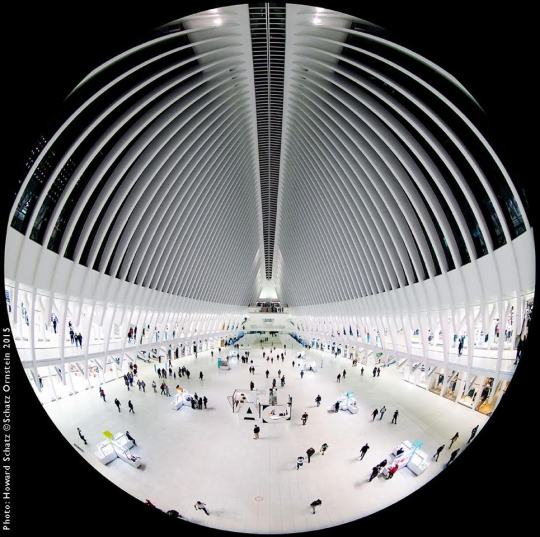
Living in New York City, walking the streets with camera in hand, offers me the privilege of making images unique to this marvelous city day or night, rain or shine, winter or summer. The density and diversity of people provide a daily treasure trove of faces to photograph.
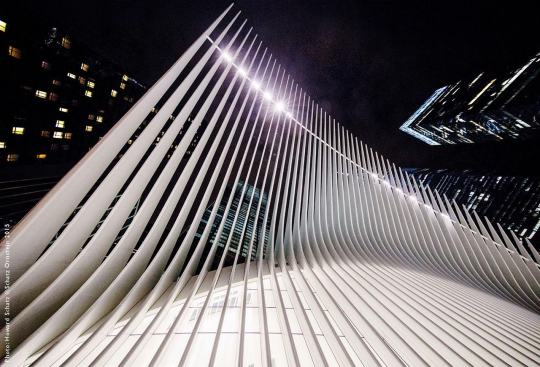
The Oculus at night, seen from the north
Along with the sea of fascinating faces, New York also offers a wealth of architecture, old and new, almost always intriguing. Though every city block is filled with images waiting to happen, every so often a walk will result in a pure visual gold vein.

East face of The Oculus; One World Trade Center building to the North and West.
Recently, an explorative walk around and through the Oculus, the World Trade Center Transportation Hub, built in the heart of downtown Manhattan, and opened in March of 2016, yielded many images but one day there wasn’t enough. I needed to return a few more times, both day and night, at busy commuter times and late at night, to take it all in.
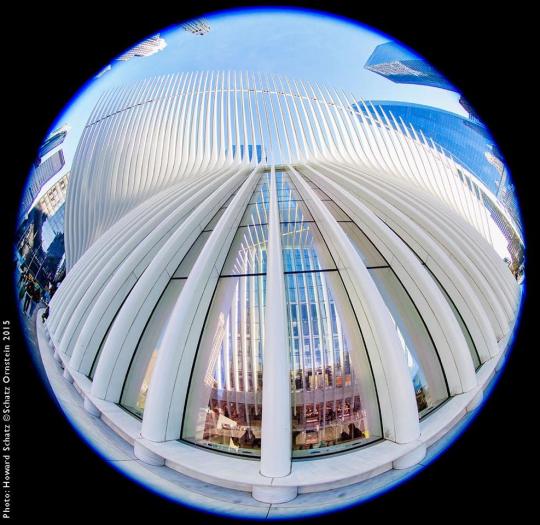
From street level: the North Face of the Oculus
The new station serves as a major transportation terminal for all of Lower Manhattan at the World Trade Center, the site of the September 11, 2001 attacks. It connects the New Jersey PATH trains to the New York City subway system, and with an underground passageway, a 600 foot tunnel, leads to the West Concourse, to the Battery Park Ferry Terminal and to Brookfield Place, the development on the far side of the West Side Highway.

The below ground 600 foot tunnel passageway to the West Concourse
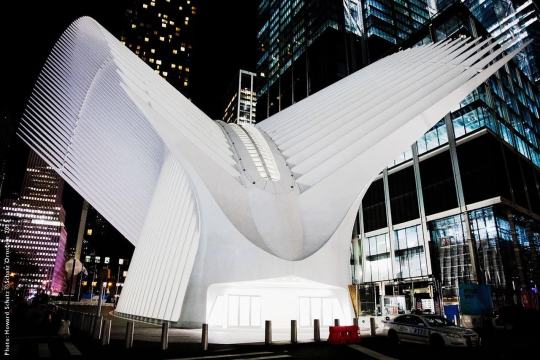
West entrance of the Oculus
Designed by the renowned Spanish architect Santiago Calatrava, the soaring structure is named after the Latin word for eye. This, for reasons that will be apparent to regular readers of this blog, appealed to me on a number of levels. The structure uses 11,500 tons of structural steel. Free from internal supporting columns, the concourse reaches a length of 350 ft and a height of 160 ft. Calatrava designed it to resemble the wings of a rising dove as a symbol of peace. The symbolism of the Oculus is further defined once a year, on the eleventh of September, when the 355-foot-long operable skylight that ranges from 12 feet wide at its most slender ends to 22 feet wide in its center is opened to the elements for 102 minutes – the elapsed time between when the first plane struck and when the second tower collapsed.
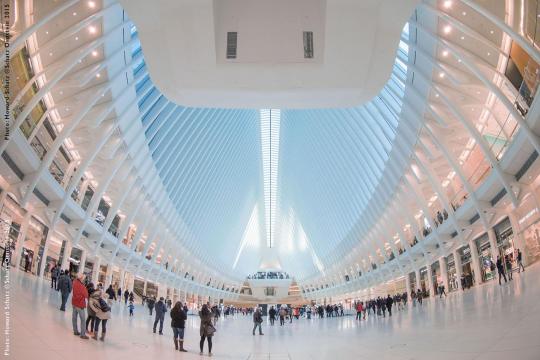
Calatrava’s design used the angle of light as a guiding principle for orienting the transportation hub; at precisely 10:28 am each September 11th (the time of the collapse of the North Tower), a beam of light would pass through the opening in the roof and project all the way down the center of the Oculus floor. Of his “living creation,” Mr. Calatrava said: “In all weather conditions, the public will experience a subtle sense of man’s vulnerability, while maintaining a link to a higher order.”

In contrast, the Oculus at night.
The many accomplishments of Calatrava are worth a careful review at: https://en.wikipedia.org/wiki/Santiago_Calatrava.

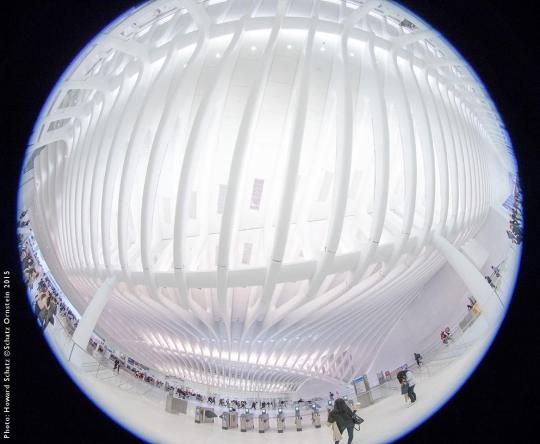
The space leading to the underground Path trains to New Jersey
The Oculus also has a large retail mall, replacing commercial space destroyed in the attack.
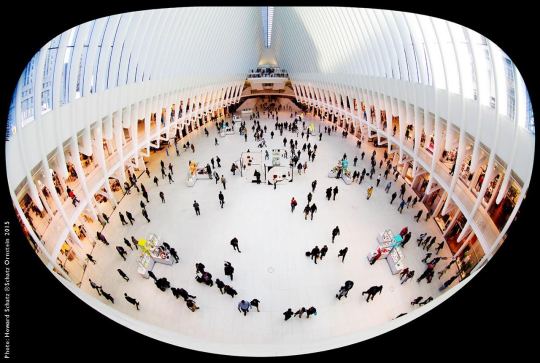
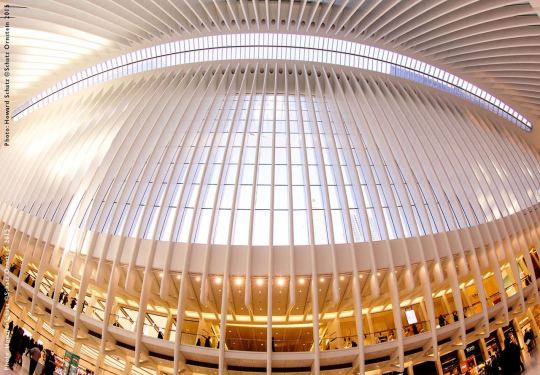
Two stories of retail spaces line each side of the Oculus.
The four billion dollar cost of the project, with its curving white steel ribs, has aroused both positive and negative reviews by well-known architectural critics, but admiration for the symbolism, creativity and immense beauty of the soaring structure abounds.
The distinguished American architecture critic, Martin Filler, so respected and well-known for his writing on modern architecture wrote a critical article regarding the rebuilding of The World Trade Center site (http://www.nybooks.com/articles/2017/03/09/world-trade-center-new-yorks-vast-flop/). He wrote that the Oculus was a, “….stupendous waste of public funds.” And that it is “…an eerily dead-feeling, retro-futuristic, Space Age Gothic shopping mall with acres of highly polished, very slippery white marble flooring like some urban tundra.“

This amazing architectural structure is a photographer’s dream, at least this photographer’s.
Whereas, Paul Goldberger of Vanity Fair wrote: “…the real point is that in a city that has built few noble public works in the last half century—a city that in our time has rarely even aspired to grandeur in public space, let alone achieved it—this project stands as a reminder that we have not given up entirely. At a time when this country spends far less on public works than it should, the Hub is a rare exception to the trend. Its best legacy would be to encourage us to take more chances, and to recognize that investing in the public realm isn’t throwing away money. It is investing in the future, a gift from our generation to the ones that follow.”
In fact, this is the first time in a half a century that New York City has built a truly sumptuous interior space for the benefit of the public.
For me, the Oculus is a breathtaking work of art, a luminous great hall in the heart of downtown Manhattan. From what I observed as I spent hours walking, looking and photographing, its beauty and dignity can’t help but inspire anyone who enters it.

Stand in the center of the gigantic main floor and look up.
You can’t help but be moved by Calatrava’s remarkable work of art.
Glitterati Incorporated, the publisher of the Retrospective, Schatz Images: 25 Years is now offering the two- book boxed set at a discount from the original price. The set comes with an 11″x14” print of the buyer’s choice.
http://schatzimages25years-glitterati.com